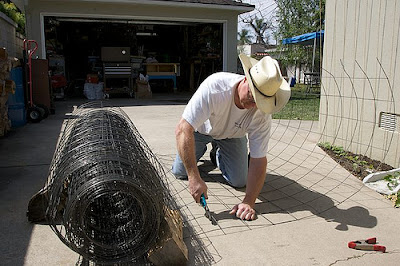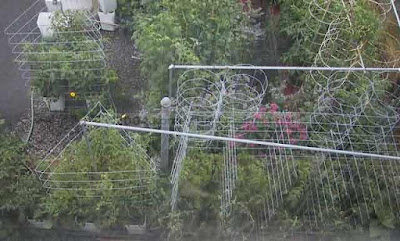Thanks to some nice people on The Tomatoville Forum I can now show you how they make their tomato cages from concrete meshing. I will quote the text from their post. I am sure you could find concrete mesh quite easily.
Please note from 3rd September Tomatoville will be a members only forum. But well worth joining if you are a tomato fan.
Home Depot sells 5x150' rolls of 6" concrete mesh for $120. Using 13 squares (6.5') per cage, one roll of mesh will make 23 cages. The full roll is heavy – 150lbs – so use a dolly or a friend to help you move it.
A-clamps or a helper will keep the roll from springing open when the ends are straightened out.
Wood, bricks or container plants can be used to manage the roll and keep it from getting away from you. (It wants to unwind more than you may want it to...)
Count out the number of 6" squares for the size cage you want – I used 13 squares – and cut each horizontal wire tightly against the 5' vertical wire. That'll make all the ends the same length and give you a clean vertical wire at the beginning of the next 6.5' length.
You can use the pliers to bend the ends – but I had a nut driver with a hole drilled about an inch or so up into the shaft. The fixed depth of the hollow gave me consistent length bends without having to measure.
Bent ends form hooks that grab the vertical wire at the other end once rolled.
Overlapping the ends by one 6" square keeps the cage round and gives you something to hold onto when hooking all the ends in place.
The cage should hold itself together without additional fasteners or welding. I used wire-ties to prevent any surprise movement or dismemberment that might occur once the cage is weighted down with tomatoes.
Thanks to Thawley for his pictures and great advice.
Here are some pictures of the cages in use. The first picture is thanks to Ruth10
Ruth's comments; The wire Thawley is using is galvanized, so no rust. This is distinct from the concrete reinforcing wire, which is not galvanized and comes "pre-rusted." I suspect the galvanized wire is slightly more expensive, but I've never done a pricing comparison of the two. And, yes, you want to watch out when you're working with those rolls. They can jump out and bite you.
I used the galvanized wire from a large roll as in Thawley's photos. A large T-bar pounded into the ground and wired on supports the cage.
Now a selection from Korney 19. With his comments
I bought galvanized sheets a few yrs ago and made a large variety of cage configurations. Triangular cages I use 1 plant in each corner. I also make 3ft x 7ft "pens" and various sizes of "stalls."
Here's a 3ft x 7ft pen that holds container tomatoes, anywhere from 8 thru 12 plants:
And here's a way to both anchor and EXTEND the height of your CRW cages:
You cut the bottom ring where it joins each vertical wire (only 1 cut per square) and then bend each down, from horizontal to a vertical position.
Finally how the larger growers use them. Pictures thanks to Granite26.
I use a 5" section of rewire cutting the bottom edge off which makes a bunch of prongs to stick into the ground. This holds them in the ground well for me.
Well that's it for now folks, I hope this post gives you some insight as to how they do it across the pond and I am sure I will be trying their method sometime next season. In future post, I will tell you more about the varieties they grow and other methods used. As I have said, the climate and conditions are different all over the globe for growing tomatoes, but basically they all like light and heat and hate frost, so we are not too far apart wherever we grow them.
















I've noted this method in the past, and been curious. I've (possibly mistakenly) assumed that it is used in areas with a long growing season and high light levels, as leaving the plants as multiple stems would mean it would take longer for fruit to form and ripen, but that eventually you would get a bigger total yield per plant. Plants are generally spaced much further apart with this method, so I suspect yield per area might be inferior to single cordons. Its big plus is the low labour input - no stringing or side-shooting.
ReplyDeleteI've experimented with not side-shooting in the past, and although the plants were healthy and seemed to resisted disease better than the cordons next to them, the crop was just too slow to ripen. I know others who swear by it, but I've not been impressed with their crop!
I've had 8' canes snapping under the load this year, so I do need to sort out something a bit more robust for next season.
Being a blonde female with blue eyes, I have absolutely no idea what a 'nut driver' is... but I'm sure boys could have a lot of fun with one. That looks like a good sturdy cage for almost any climbing plant to grow up. Personaly I will stick to my bamboo canes, tripod lashing and round turn and two half hitches (courtesy of girl guides training!) xx
ReplyDeleteThose Tomatoes look really good in those outside cages Steve,wish i could grow them how you have them,the blackbirds here in NZ would have the lot so i have to grow under nets.
ReplyDeleteIn my tunnlhouse i grow a bit like how Steve does in the cages,but the only difference is i start off the plants by growing only three cordons and remove side shoots as they grows taller but i dont remove the tiny shoots that grow near ground level.
Once the first cordons reach the roof and are producing fruit the other small shoots will be slowly growing and will tend to grow flowers closer to ground level than the first main cordons.
After most of the fruit has been picked for some reason the ground level shoots tend to grow faster and end up giving a second crop,its about now i start to remove the first cordons,last season i had some plants that grew a third crop and produced for 8 months.
Ive just gone outside and got a photo of what i mean,you can see the lower shoots which i need to thin out to three only.
http://i416.photobucket.com/albums/pp247/Medburygardens/Picture770.jpg
Richard all the pictures on this post are from other people in the States, but i wish I could grow in cages like that.
ReplyDeleteSteve
The remesh I bought from Home Depot looked just like yours -- $105 for 150 feet -- but was a bit disappointing. Lots of the welds broke as I tried to make the cages. The 10 gauge wire seemed fine, it just didn't hold together real well. I used a lot of zip ties to try to fix things.
ReplyDeleteTo keep welds from breaking, get a piece of rebar or 2x4 that's longer than the mesh height. As the mesh is unrolled, lay the bar across the center of each mesh square and have it held down while you lift on the mesh putting a small bend in each square. When you cut the mesh, the cage will have a built in curve stopping the welds from breaking.
ReplyDeleteKeep the welds on the inside when making the cage also helps, it also keeps the outside of the cage smooth.
By doing both of these things, we've had the same cages for 34 years! My brother & I had 200+ plants, we used to sell tomatoes to local restaurants from '80-'85 for .45-.75/lb which was .10-.20/lb under their vendors. Selling 100lb+/day not bad money if you can do it(pick,clean,sort,deliver), we were teenagers.
Nieces & nephews do it now, same lucky cages.